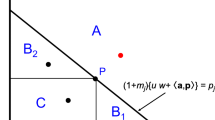Abstract
There are clear benefits associated with a particular consumer choice for many current markets. For example, as we consider here, some products might carry environmental or ‘green’ benefits. Some consumers might value these benefits while others do not. However, as evidenced by myriad failed attempts of environmental products to maintain even a niche market, such benefits do not necessarily outweigh the extra purchasing cost. The question we pose is, how can such an initially economically-disadvantaged green product evolve to hold the greater share of the market? We present a simple mathematical model for the dynamics of product competition in a heterogeneous consumer population. Our model preassigns a hierarchy to the products, which designates the consumer choice when prices are comparable, while prices are dynamically rescaled to reflect increasing returns to scale. Our approach allows us to model many scenarios of technology substitution and provides a method for generalizing market forces. With this model, we begin to forecast irreversible trends associated with consumer dynamics as well as policies that could be made to influence transitions.
Article PDF
Similar content being viewed by others
Explore related subjects
Discover the latest articles, news and stories from top researchers in related subjects.Avoid common mistakes on your manuscript.
References
Arthur B (1994) Increasing returns and path dependence in the economy. University of Michigan Press, Ann Arbor
Bousquet F, Lifran R, Tidball M, Thoyer S, Antona M (2001) Agent-based modelling, game theory, and natural resource management issues. J Artif Soc Soc Simul 4(2). Available at http://www.soc.surrey.ac.uk/JASSS/4/2/0.html
Coleman JS (1990) Foundations of social theory. The Belknap Press of Harvard University Press, Cambridge
Föllmer H (1974) Random economies with many interacting agents. J Math Econ 1:51–62
Gordon MB, Nadal J-P, Phan D, Semeshenko V (2007) Discrete choices under social influence: generic properties. Available at http://halshs.archives-ouvertes.fr/halshs-00135405
Geels FW (2007) Transformation of large technical systems: a multilevel analysis of the Dutch highway system (1950–2000). Sci Technol Human Values 32:123–149
Geels FW, Schot J (2007) Typology of sociotechnical transition pathways. Res Policy 36:388–417
Gordon MB, Nadal J-P, Phan D, Vannimenus J (2005) Seller’s dilemma due to social interactions between customers. Phys A 356:628–640
Kemp R (1998) The diffusion of biological waste-water treatment plants in the Dutch food and beverage industry. Environ Res Econ 12:113–136
Kittel CH, Kroemer H (1980) Thermal physics, 2nd edn. Freeman, New York
Lindenberg SM (1992a) The method of decreasing abstraction. In: Coleman JS, Fararo TJ (eds) Rational choice theory: advocacy and critique. Sage, Newbury Park, pp 3–20
Nadal J-P, Phan D, Gordon MB, Vannimenus J (2005) Multiple equilibria in a monopoly market with heterogeneous agents and externalities. Quant Finance 5:557–568
Popper K (1992) The logic of scientific discovery, 2nd edn. Routledge, London
Weisbuch G (2000) Environment and institutions: a complex dynamical systems approach. Ecol Econ 35:381–391
Weisbuch G, Kirman AP, Herreiner DK (2000) Market organisation and trading relationships. Econ J 110:411–436
Author information
Authors and Affiliations
Corresponding author
Rights and permissions
Open Access This is an open access article distributed under the terms of the Creative Commons Attribution Noncommercial License (https://creativecommons.org/licenses/by-nc/2.0), which permits any noncommercial use, distribution, and reproduction in any medium, provided the original author(s) and source are credited.
About this article
Cite this article
Weisbuch, G., Buskens, V. & Vuong, L. Heterogeneity and increasing returns may drive socio-economic transitions. Comput Math Organiz Theor 14, 376–390 (2008). https://doi.org/10.1007/s10588-008-9033-3
Published:
Issue Date:
DOI: https://doi.org/10.1007/s10588-008-9033-3




